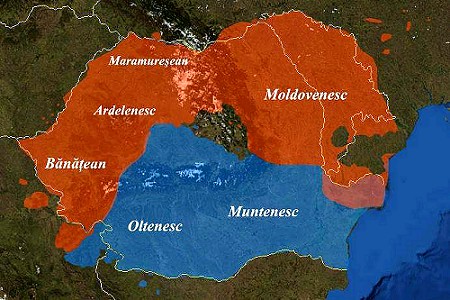 |
|
Geographic
distribution of the four Romanian languages |
Romanian Languages and Dialects
The Romanian language is an Eastern
Romance language that derives from the Latin that was introduced during
the Roman occupation of Eastern Europe and the Balkans. The recruitment
of Thracians, Illyrians and Celts into the Roman army gradually spread
the use of Latin throughout the Balkan region. Many sources have defined
a line for the divide of Greek and Latin usage at this time which runs
across modern Macedonia and Bulgaria below the Balkan mountains.
The Romanian language contains features
reflecting continued contact with Romans until the decline of the Roman
Empire and the influx of Slavic peoples in the 6th century. From this
period time came the separation of northern and southern Romanian
dialects. The two principle northern dialects are Daco-Romanian which is
spoken in modern Romania and the Republic of Moldova, and Istro-Romanian
which is miraculously still spoken in a few isolated villages in Istria.
The two principle southern dialects are Arumanian or Macedo-Romanian
which are spoken in Macedonia, Albania and Greece, and Megleno-Romanian
which is spoken in a few villages in Greece. Romanian
[which dialect?] is
still the first language of many Romanian Jews who now live in Israel.
The Eastern Romance (Romanian) line
began to further split from
two principle dialects into four separate ones
between 500 and 1000 A.D., more specifically around 600 A.D. after the
Slavic Invasion. The Daco-Romanian dialect
then separated from the three dialects
that were spoken south of the Danube - that is, Macedo-Romanian,
Istro-Romanian and Megleno-Romanian. It is believed that these
three
dialects became fully distinct from
Daco-Romanian during the 9th-10th centuries, with Istro-Romanian
splitting later than the other two.
The most widely spoken is the Daco-Romanian
language which today is known simply as
Romanian. This is the official language that is spoken by over 26
million people in present-day Romania and Moldovia.
Aromunian (also known as Macedo-Romanian),
Megleno-Romanian and Istro-Romanian are spoken in small
communities scattered over the Balkan Peninsula
as shown in the above map. Linguistically, Istro-Romanian
is the closest to
Daco-Romanian, but according to the
Ethnologue: Languages of the World, Istro-Romanian it is structurally
considered to be a
separate language from Romanian (F.B. Agard).
The following are the four Romanian
dialects which are sometimes referred to as separate languages:
|
Language
|
Native speakers
|
Geographic distribution
|
|
Aromunian / Macedo-Romanian |
111,000
|
Albania, Bulgaria, Greece, Macedonia
|
|
Daco-Romanian |
26,000,000
|
Romania, Moldavia, Ukraine, Hungary
|
|
Megleno-Romanian |
12,000
|
Greece
|
|
Istro-Romanian |
555
|
Istria (in present-day Croatia). Not included in
these numbers are the people who were scattered around the world after World War
II and who still include native speakers. They reside primarily in the United
States of America, but also found in Argentina, Australia, Canada, Germany, Italy,
Slovenia, Serbia, Sweden, and possibly other countries. |
Note: The date of these population statistics is unknown, and may not
reflect current conditions.
 |
|
Major varieties of Daco-Romanian
(official Romanian) |
Daco-Romanian (official
Romanian)
Romanian dialects (or varieties) are
not as varied as are many other Romance languages. Romanians
themselves refer to them as graiuri or
speeches/varieties rather than dialects. These graiuri
(speeches) are within the Daco-Romanian dialect/language only
and are not to be confused with the Aromanian, Megleno-Romanian
and Istro-Romanian dialects which are mostly spoken south of the
Danube and which are at times considered to be languages in
their own right. (Please note, that we shall not further discuss
the Aromunian / Macedo-Romanian or Megleno-Romanian dialects
which are widely covered on other internet sites.) The
differences between the varieties of Daco-Romanian are small and
mainly in vocabulary and in phonology, as the grammar is almost
identical all over the area inhabited by Romanians. This makes
the Romanian language mutually intelligible over the entire
territory inhabited by Romanians.
Romanian is divided into several
"graiuri" ('speeches'):
- the northern varieties - Moldavia,
Banat and most of Transylvania
-
Banat (bănăţeană)
-
Maramureş (maramureşeană)
-
Moldavia (moldoveneşte) -- also spoken in the northern part
of Dobruja
- Ardeal (Transylvania) (ardeleneşte)
- the southern varieties - in Southern
Transylvania (Făgăraş and Braşov areas), Wallachia and southern part
of Dobruja
-
Muntenia (munteneşte) -- spoken in Bucharest and the basis
of the standard language.
-
Oltenia (olteneşte)
-
Eastern Serbia
Source:
http://en.wikipedia.org/wiki/Romanian_dialects
Istro-Romanian
According to the
Ethnologue: Languages of the World, Istro-Romanian is an Eastern
Romance language that fits in the linguistic tree as follows:
-
Indo-European (449)
-
Italic (48)
-
Romance (47)
-
Eastern (4)
-
Istro-Romanian
-
Aromunian (Macedo-Romanian)
-
Daco-Romanian (standard Romanian)
-
Megleno-Romanian
The
Ethnologue calls Istro-Romanian a structurally separate language
from Romanian (F.B. Agard), as also are Aromunian and Megleno-Romanian.
Traditional Romanian linguists, however, consider all three to be
dialects of standard Romanian - that is, of Daco-Romanian.
There is another view that the
Istro-Romanian speech is closer to the extinct Dalmatian language than
to Romanian, but this theory is rejected by most linguists. Some loan
words suggest that before coming to Istria, Istro-Romanians lived for a
longer period of time in Northern Dalmatia - on the route westward from
their place of origin in current Romania - but there is no documented
evidence of it, plus such theory has produced contradictory
permutations. Even if it were so, the Istro-Romanian language
nonetheless shows some features that are unmistakably Romanian, whereas
even Daco-Romanian has Slavic loan words. It is a well known fact that
of all the Eastern Romance tongues spoken outside of present-day
Romania, Istro-Romanian is linguistically the closest to Daco-Romanian
than to any other language.
Sources:
- http://www.ethnologue.com
-
http://www.eliznik.org.uk/RomaniaHistory/language.htm
|